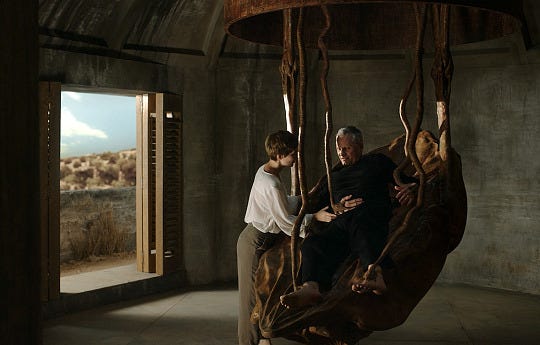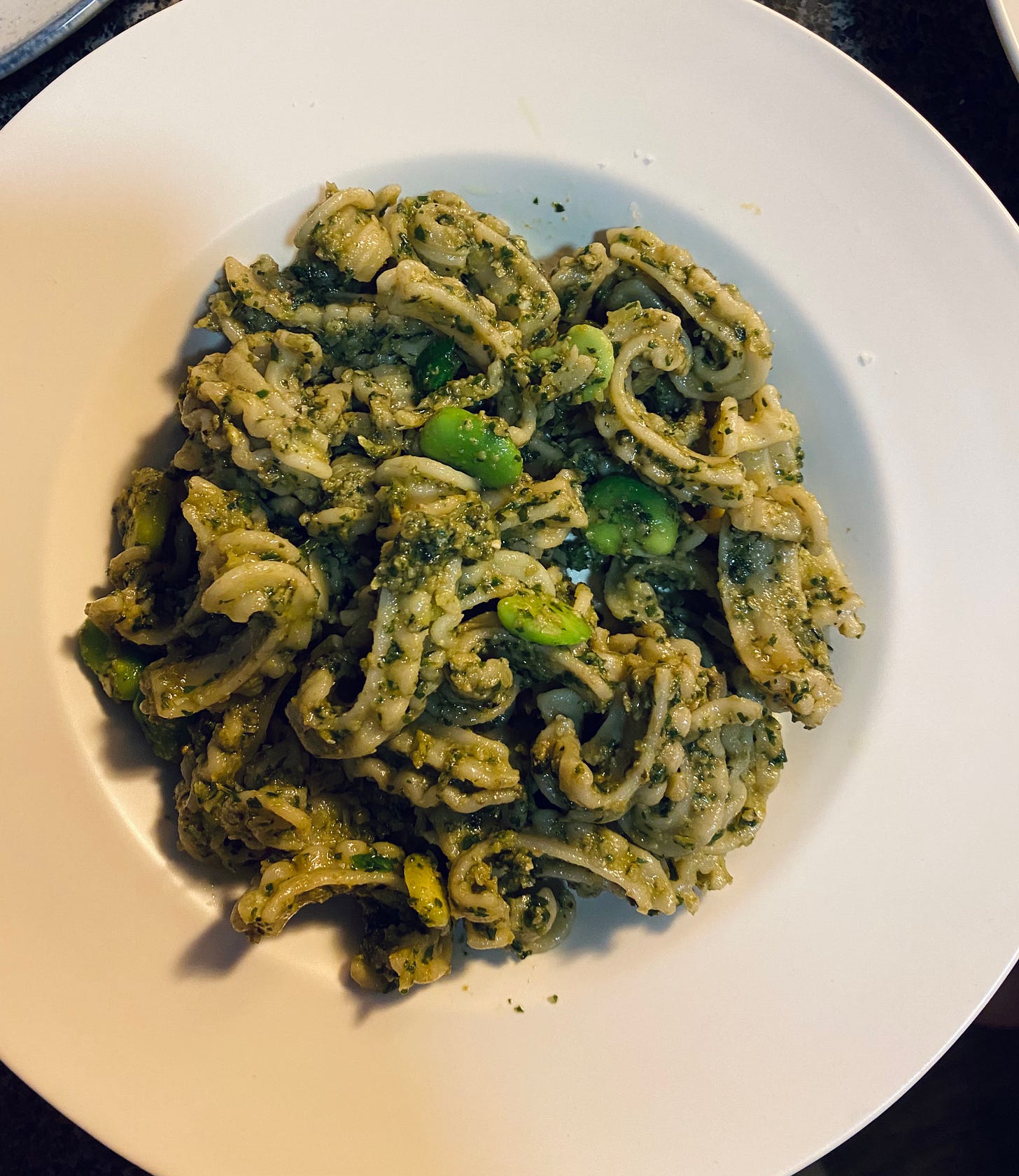I. Short takes
II. Cronenbergs, younger and elder
III. American amaro
IV. Tasting notes (things I ate)
Presented with the inflight entertainment system, I seize the opportunity to watch a very specific kind of movie: something I don’t have access to, wouldn't pay money for, that declares itself “off-brand,” or nags at my curiosity. Plane movies aren’t bad movies; in fact they can be quite excellent. They’re more like preemptive guilty pleasures that cost nothing, neither my money nor time, since, presumably, I have a lot of that on hand. Tell me what you queue up, if you dare.
PLANE MOVIES
THE LOST CITY casts Channing Tatum in peak himbo form, an incarnation he’s mostly outgrown. But the breezy chemistry with Sandra Bullock renders this a painless hijinx. The movie pays homage to ROMANCING THE STONE the PG-Zemeckis, where a mudslide lands an oily Michael Douglas facedown in Kathleen Turner’s crotch in the jungles of Colombia.
In WHERE’D YOU GO BERNADETTE Cate Blanchett transforms what read on the page as “kooky-neurotic-but-loving-mom” into an abrasively self-pitying, invective-spewing depressive out of a Jonathan Franzen novel. I shriveled up in my seat. I’d read Maria Semple’s nimble book, on which this is based, but not expected to experience such emotional turbulence, especially since Linklater has otherwise rendered the movie into a wonkish dollhouse. I also love how Bernadette goes to town on a Cinnabun mid-flight, simultaneously conceding her dignity and giving the finger to commercial air travel, and everything else. (Suddenly I am reminded of this, and realizing Oceans 8 is a perfect plane movie.)
SECOND ACT + I FEEL PRETTY + WHAT WOMEN WANT: Only by otherworldly mishaps (amnesia, voodoo) or inadvertent lies (catfishing) does the American woman (Amy Schumer, Taraji P. Henson, and J-Lo) find success in the corporate workplace.
ANTIVIRAL
Brandon Cronenberg, 2012
Cronenberg the Younger presents us with a calculatedly sleek future, discharged of any earth-shattering revelations. People head to cutting edge clinics, like the one Syd March (Caleb Landry Jones) works at, to transact the latest celebrity bacterium like they’re at the credit union or Cartier. He shills them “the latest Hannah,” bespoke germs from the famous blonde bombshell who contracts exclusively with their firm. The public desire for filth runs counter to the mise-en-scene of gleaming white surfaces and minimal clutter, as well as the reptilian Jones, a befitting exemplar of pallor.
The people of the future’s obsession with the stars isn't limited to their microbes — it extends to their molecules, their fat and protein. Scientist-cum-butchers engineer chucks and rounds from celebrities’ cells, so you can become one with the flesh in ways never imagined. (It’s in these scenes that the director most recalls the work of his father, though with a drowsy melancholy, not mischievousness, that’s improved upon in his sophomore effort, Possessor.)
The story swirls into some minor corporate conspiracies: Syd moonlights as a pathogen-trafficker, which requires injecting himself with the copyrighted viruses and catching a particularly bad one. But Cronenberg drills down on the main points, our obsession with celebrity, with the dull force of a minor headache.
CRIMES OF THE FUTURE
David Cronenberg, 2022
The director’s preoccupation with the body vis-a-vis technology, and its consequences on our morality, are shot through with startling and baleful tenderness.
When I described this movie to friends and strangers as the new one with Lea Seydoux, each and every one countered with “oh, the Kristen Stewart movie.” I forget the Twilight Star’s initial appeal to the mainstream, but if that’s what it takes to bring the Canadian auteur of body horror to the masses, then I’m here for it. Stewart plays a skittishly randy bureaucrat at the National Organ Registry alongside the puckish Don McKeller who telegraphs his character’s intellectual boner through his eyebrows. The object of their affection: performance artist Saul Tenser (Viggo Mortensen), swathed in a black get-up resembling a nun’s habit by way of Rick Owens, and of course the crimson scrubs of Dead Ringers.
In the abysmal yet tidy future, people are unfazed by pain and their derelict surroundings — dilapidated Grecian villas, fit for staging a rave. Body modifications are the rage, arbitrary organ growths and mutations are de rigueur, and some have developed a predisposition for eating microplastics. Saul chooses to remove his vestigial growths on stage, public autopsy style, in a demonstration bodily autonomy. His professional and romantic partner (Lea Seydoux, every bit the gamine) performs the surgeries, remotely but an arms length away, by effortlessly sliding her fingers around a squishy jellied console.
Great art often necessitates a sort of bodily surrender, and Cronenberg literalizes the struggle: Every adventure under the knife wearies and weakens Saul, his pained body neither relaxed nor comforted by high-tech gizmos like a semi-sentient orthopedic bed suspended from the ceiling.
Seemingly subversive, the political nature of his art is quite conservative given the rumblings of a burgeoning radical subgroup whose existence is imperiled by the government. The crimes of the future are not totally dissimilar from crimes of today, where human bodies are policed by the state…
Cronenberg politely fumbles the genre elements, largely secondary to the film’s sinuously erudite dialogue that allows the principals to ponder aloud the intertwinings of pleasure, destruction, art, technology, and more, all extensions of our bodies.
Among the ingenious tactile props in the movie are that chestnut bed, meant to cradle your spine, and similarly, a rigid chair made of bones meant to aid digestion. Rather than feed you, this jerky animatronic, a high-chair for the modern age, wrenches and lurches its varied parts to lift and contort your body to achieve some sort of digestive asana. Saul, seated on the freakish throne, spoons green or red mush from a metal tray into his mouth, hoping for the best. It’s a droll but chuckle-worthy bit, that like the best of Cronenberg movies, echoes a deeper sentiment, here one of pain. To eat is to live, and the man can’t keep his food down. (Did the low-squat, Saul’s preferred posture, not require above-average levels of lower-body strength, I would have guessed he was malnourished.)
Anyone who has endured an inexplicable dyspepsia can relate; I know I can. Earlier this year I suffered extended periods of feeling like there was a balloon expanding in my stomach or a frog caught in my throat. Saul’s digestive dilemma resolves itself in the film’s final scene,** one of unforeseen tenderness and gustatory fulfillment, if not pleasure, corroborating the idea that you are what you eat. Unlocking the mystery of his consumption illuminates his fate and brings meaning to his identity — as artist, person, and human.
**The final image also brilliantly and boldly harks back to the ending of Dreyer’s The Passion of Joan of Arc.
For me, the fix was much simpler: kiwis. The under-the-radar superfruit contains potent levels of vitamin C and an enzyme called actinidain, which has been clinically proven to improve your digestive and metabolic health.
The enzyme is also what renders the kiwi a most competent meat tenderizer. My mother recently regaled me with a story about how, long ago, the bulgogi she catered for my high school graduation bbq had too many kiwis in the marinade — so much that the sirloin disintegrated into threads before making its way onto the grill.
American amaro
Digestifs are a class of post-meal liqueurs, meant to to aid digestion — though most self-respecting medical professionals would let you know that drinking almost (almost) never has any bettering effect on your physical health. Amaro are the bitter Italian version, distilled from a melange of herbs, flowering plants, even nuts. The flavors and mouth feels might land anywhere between earthy root beer and orange cinnamon, syrupy licorice to inky menthol.
Recently craft distillers have been making Italian-style digestifs with their own unique spin all over the country, which has helped to cement stateside amaros as a full-fledged trend that’s here to stay. One of the earliest versions comes from Forthave Distillers. I count their complex, chamomile-like amaro among my favorites.
Frequently lining the shelves these days are another Brooklyn brand, Faccia Brutto, which makes two distinct amari, and even a nocino, walnut-based (if you happen to try it, let me know). The sharp amaro gorini is ideal with a marachino cherry.
The Heirloom Spirits Pineapple Amaro is vaguely tropical-leaning, though I wouldn’t call it fruity. I’m finally got to try this hard-to-find drink the West Coast thanks to beer bar Spuyten Duyvil, which reemerged trading in a most rare bounty of amaro.
Also of note: Wigle’s saffron amaro. I taste very little of the world’s costliest spice in this liquor from Pittsburgh whiskey-makers, but love it nonetheless. It reminds me perplexingly, though not unappealing, of bubblegum.
THE MOST PERFECT SPRING DISH
The greenmarket is ripe with fava beans, which everyone knows is the real vaunted harbinger of spring, not ramps. I learned from the Six Seasons cookbook to make a pesto with the beans after shelling and blanching (though not always shelling a second time, thanks to what I learned from Gjielina), alongside basil, parsley, mint, and pistachio.
UPGRADE YOUR FRIES
After attending chef Mari Fuentes’ Puerto Rican-inspired pop-up dinner at Rolo’s, I think all fries should be yucca fries, especially when they’re draped over with escabeche. I arrived early to dinner thinking I’d get a quiet drink at the bar, but it was rollicking — on Tuesday. Inside were scores of neighborhood dads, outside a large party of young people that had me mistaking Ridgewood for Dimes Square. I spied Margiela tabi flats and tees from a trendy Korean-Uzbek designer, whose hole-punched designs have been biding their time in my online shopping cart.
CHICKEN FOR BREAKFAST
I’m not a brunch person, but I would dine at the appointed hour with the crowds if it meant eating the fried chicken at Home grown smothered with pork gravy atop a biscuit. Luckily I don’t have to go all the way to the South since Brown Butter, just a walk away, has a chicken biscuit on their weekday lunch menu.














